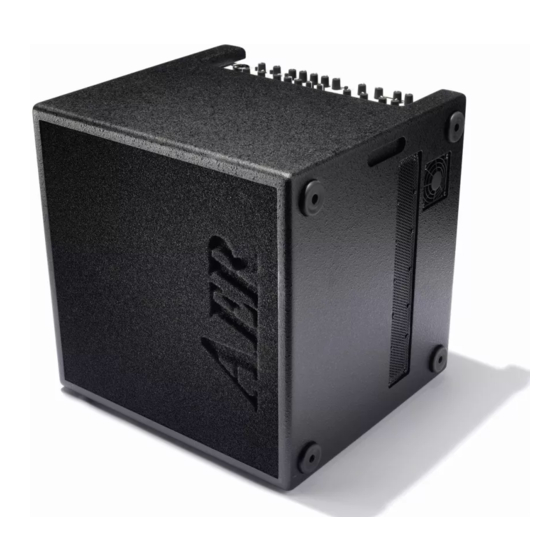
Advertisement
Basscube
Operating Instructions
Contents:
1. Introduction
1. Introduction
Welcome to AER. Thank you for purchasing the
BASSCUBE.
You have chosen a professional, compact and pow-
erful amplifier that was specially developed toam-
plify acoustic and electric bass instruments.
The BASSCUBE unfolds particularly impressive
qualities with the double-bass, whether plucked or
bowed. Although the range of bass tones is huge
and their tone variety is enormous, we think we
have found more than just a "good compromise".
Advertisement

Summary of Contents for AER Basscube
-
Page 1: Table Of Contents
4. Operating Elements 5. Summary of Operations 6. Technical Data 1. Introduction Welcome to AER. Thank you for purchasing the BASSCUBE. You have chosen a professional, compact and pow- erful amplifier that was specially developed toam- plify acoustic and electric bass instruments. -
Page 2: Precautionary Measures
Basscube 2. Precautionary Measures When you use your BASSCUBE, always take basic safety precautions to reduce to a minimum the risk of injury by fire or by electric shock. • Do not operate your BASSCUBE near devices with • Read all the directions in these operating instruc- strong electromagnetic fields such as large mains tions and make sure that you understand them. -
Page 3: Our Idea
Basscube 3. Our Idea The BASSCUBE is fundamentally different from oth- 2.) The “bass” is a very demanding instrument as far er amplifiers on the market. as its tone is concerned. Its soundproducing capac- ity ranges over the entire audio spectrum. Howev-... - Page 4 Basscube how varied the problem is and why we followed • The BASSCUBE is “two-way-active”, that is, there radically different paths when we set out to realise is an additional dome tweeter with active frequen- our tone ideas in order to make the bass sound the cy crossover and its own power amplifier with 60 way it wants to sound.
-
Page 5: Operating Elements
Basscube 4. Operating Elements Front (seen from above, from left to right): input channel 1 input channel 3 select clip colour clip voice 48 V line piezo gain harmonics bass mid-freq mid-level treble gain bass treble effect voice return channel 2... - Page 6 LED indicator: 9 V phantom source asymmetrical for on – permits voltage supply to an line input (magnetic electronic internal bass-unit from pick-up or piezoelectric the BASSCUBE with preamplifier) and Clip overload indicator an XLR male socket Gain input level control...
- Page 7 Basscube Phantom (supplementary source voltage): 48 V 48 V on or off (for all microphone inputs) 48 V 9 V on or off (only channel 2 to supply an active electronic unit) effect Return: level-control for the auxiliary return input (tape-in, RCA phono-plug)
- Page 8 Basscube Rear (from left to right): BassCube DI-out XLR direct output before the master-control DI-level DI level-control, trim potentiometer DI-out Line preamplifier output before master-control 1 = grd 2 = pos 3 = neg • Insert stereo jack to switch off...
-
Page 9: Summary Of Operations
However, you can switch the voltage between 110 if we are right. However, we are of the opinion that and 230 volts if you wish to operate the BASSCUBE more is needed in order to make an instrument sound in another part of the world. For this purpose, re- balanced. - Page 10 (minimum im- namic support to the voice. pedance 8 Ohm). O.K.? We hope you enjoy your BASSCUBE! Further outputs: DI-out The composite signal after tone control but without effect and before master control lies on the XLR socket.
-
Page 11: Specifications
Basscube -11- 5. Technical Data Inputs: Analog Signal Processor: limiter, displacement filter Ch1: XLR-Combi line: unbalanced, 1 MEG, stereo, Power Amp: (ring: 9V/15V phantom power) Powerconsumption: piezo: unbalanced, >10 MEG, Bultra 220-240 V / 50-60Hz / high impedance inputstage 400 VA (110V / 50-60Hz)
















Need help?
Do you have a question about the Basscube and is the answer not in the manual?
Questions and answers